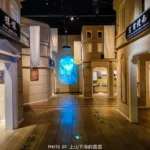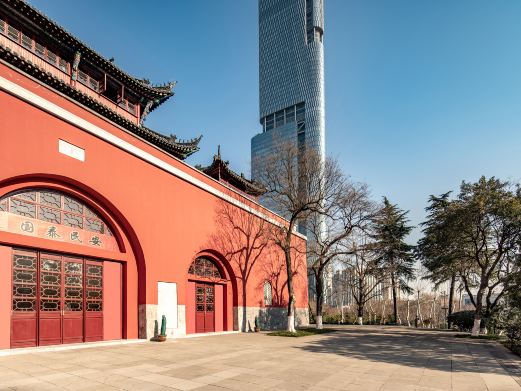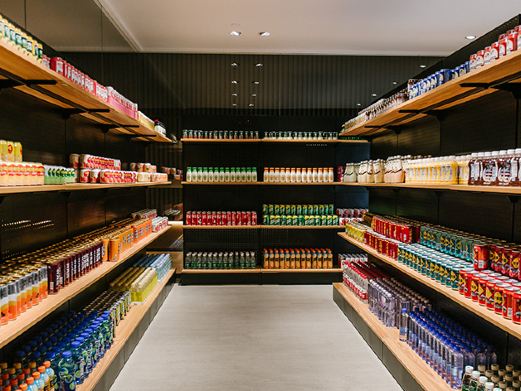Chengkan is located 31 kilometers north of Tunxi District, Huangshan City. It is laid out according to the yin-yang bagua. The scenery is not inferior to that of Hongcun, but it is not as famous. Many of the three-story Ming Dynasty buildings here can be regarded as ancient ‘tall buildings’; there are also rare Song and Yuan Dynasty buildings; and the exquisite Baolun Pavilion is one of the best among all Huizhou ancient villages. There are multiple roads to enter Chengkan. The main entrance and ticket office are in the southwest corner, and Chengkan passenger station is also on the southwest side. 100 meters away from the ticket office is a viewing platform where you can take a panoramic view of Chengkan. There is a hill on the right front of the viewing platform. There is a small Huizhou-style village on the hill, which is also a place to take a panoramic view. Every April, when the rape blossoms at the entrance of the village bloom, the scenery is extremely beautiful. At the main entrance of Chengkan, there is a lake (water gap), like the South Lake in Hongcun. There is also a bridge on the lake. The white walls and black tiles are reflected in the lake. It is an extremely beautiful place for taking pictures. In summer, you can enjoy the lotus flowers in the lake. In the late Tang Dynasty, the Luo brothers moved to Chengkan. The Luo family and their descendants built the village into a bagua village in line with yin-yang bagua. The streets and alleys lead in all directions. After entering the village, it is like entering a bagua maze. It is recommended to hire a tour guide at the entrance of the scenic area so that you won’t miss important scenic spots in the maze. For things like bagua, you also need someone to explain to understand. Due to the limited number of tour guides, local people in the village will recommend themselves as ‘unofficial tour guides’. Some important buildings may not be accessible to unofficial tour guides. They can only explain a few words at the door. Some local people can only speak dialects. Remember to find someone who can speak Mandarin and negotiate a good price to avoid unhappiness later. The tour route generally follows the order from west to east. If you are looking for ‘antiquity’, the Changchun Society of the Song Dynasty is very old. It is in the southeast corner of the village and is a place for worshiping the land god. The Huanshou Bridge of the Yuan Dynasty is in the northeast of the village. There is a pavilion at the bridgehead. In Huanshouxuan by the bridge, there are many old Huizhou wood carvings and embroideries collected. The Luo Huitai House of the Yuan Dynasty is also of long history. If you want to see ‘exquisite architecture’, the Baolun Pavilion of the Ming Dynasty (Zhenjing Mr. Luo Dongshu’s Ancestral Hall) is a must-see. It is in the northeast of the village. This is a three-entry ancestral hall. The first entry is the instrument gate; the second entry is the hall. The plaque on the hall was written by Dong Qichang. The several golden nanmu pillars in the hall are priceless. The third entry is the Baolun Pavilion. After entering, be sure to look up at the roof. There are carvings on both ends of the beams. Most of the beams have painted patterns. The wonderful thing is that some of the colors can still be faintly discerned. It is extremely beautiful! The Yanyi Hall and Luo Runkun’s House of the Ming Dynasty are both worth seeing. Yanyi Hall is located at No. 1, Tiandeng Alley. It is three stories high. The gate full of iron nails and the components on the beams and columns are impressive. Luo Runkun’s house number is ’66, Front Street’. It is two stories high. The carvings on the windows are exquisite. The beauty’s couch and window rail upstairs are also very beautiful. In the southeast corner outside the village, the Longxing Bridge, a large single-arch stone bridge of the Ming Dynasty, can also be visited.
The commercialization degree of Chenkan is not high, so the catering and accommodation are not so developed. You can buy some water tofu and hairy tofu from vendors to taste. It is said to be relatively good in Huangshan City. There is also accommodation in the village, but not much. If you want to eat and stay, it is recommended to go to Chenkan Town outside. The Qiankou Folk Houses gathering various Huizhou architecture are about 8 kilometers away from Chenkan. Tangmo, a Huizhou-style village, is about 4 kilometers away from Qiankou Folk Houses. They can be visited on the same line. Opening hours: Open all year round from 07:30 to 17:30. Preferential policies: Children: For children under 6 years old (inclusive) and under 1.2 meters in height, they are free with height or valid documents. For those aged 6 years old (exclusive) to 18 years old (inclusive), they can get discounted tickets according to their actual height. Elderly: For those aged 65 years old (inclusive) and above, they are free with senior citizen card or ID card. For those aged 60 years old (inclusive) to 65 years old (exclusive), they can get discounted tickets with senior citizen card or ID card. Students: Full-time students of colleges, middle schools and primary schools (excluding adult education and graduate students) can get discounted tickets with student ID cards. Disabled people: They are free with disability certificate. Military personnel: Active-duty military personnel, disabled military personnel and retired military cadres are free with officer ID cards. Tour guides accompanying groups: They are free with valid documents. Supplementary note: The above information is for reference only. The specific information shall be subject to the disclosure on the day at the scenic spot. Service facilities: Parking lot: [Chenkan Scenic Area Parking Lot]. Reference price: charged. Address: at the main entrance of the scenic area. Number of parking spaces: 100. WiFi: Account: chengkan. Password: no password. Coverage: tourist center. Luggage storage: Reference price: free. Toilets: There are multiple toilets in the park, all with signs.









